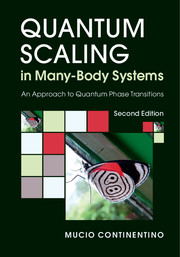Book contents
- Frontmatter
- Dedication
- Contents
- Preface
- 1 Scaling Theory of Quantum Critical Phenomena
- 2 Landau and Gaussian Theories
- 3 Real Space Renormalisation Group Approach
- 4 Renormalisation Group: the ∊-Expansion
- 5 Quantum Phase Transitions
- 6 Heavy Fermions
- 7 A Microscopic Model for Heavy Fermions
- 8 Metal and Superfluid–Insulator Transitions
- 9 Density-Driven Metal–Insulator Transitions
- 10 Mott Transitions
- 11 The Non-Linear Sigma Model
- 12 Superconductor Quantum Critical Points
- 13 Topological Quantum Phase Transitions
- 14 Fluctuation-Induced Quantum Phase Transitions
- 15 Scaling Theory of First-Order Quantum Phase Transitions
- Appendix
- References
- Index
13 - Topological Quantum Phase Transitions
Published online by Cambridge University Press: 04 May 2017
- Frontmatter
- Dedication
- Contents
- Preface
- 1 Scaling Theory of Quantum Critical Phenomena
- 2 Landau and Gaussian Theories
- 3 Real Space Renormalisation Group Approach
- 4 Renormalisation Group: the ∊-Expansion
- 5 Quantum Phase Transitions
- 6 Heavy Fermions
- 7 A Microscopic Model for Heavy Fermions
- 8 Metal and Superfluid–Insulator Transitions
- 9 Density-Driven Metal–Insulator Transitions
- 10 Mott Transitions
- 11 The Non-Linear Sigma Model
- 12 Superconductor Quantum Critical Points
- 13 Topological Quantum Phase Transitions
- 14 Fluctuation-Induced Quantum Phase Transitions
- 15 Scaling Theory of First-Order Quantum Phase Transitions
- Appendix
- References
- Index
Summary
The Landau Paradigm
The usual paradigm to describe phase transitions is that of Landau. It is based on an expansion of a free energy functional or an action in terms of an order parameter. Close to the phase transition the order parameter is small, and only terms dictated by symmetry are allowed in this expansion. Associated with this paradigm are many important ideas, such as that of broken symmetry and Goldstone modes. The extension of this paradigm to include quantum phase transitions certainly brought new ideas and progress, as we have seen in this book: the inextricability between the dynamics and static properties, the modified hyperscaling relation with the notion of an effective dimensionality, the role of the uncertainty principle linking energy and temporal fluctuations and so on. The underlying principle here is always that of symmetry. However, as we will see in this chapter, this paradigm is not sufficient to describe certain classes of phenomena that do not involve symmetry changes but are nonetheless still associated with diverging lengths, singularities and critical exponents: features that are clearly related to critical phenomena and phase transitions. We have already met similar behaviour when studying density-driven or Lifshitz transitions. We will see in this chapter that these transitions are much more common and interesting that initially thought. The keyword here is topology, which contains principles and constraints that protect quasi-particle excitations and are still more powerful than those of symmetry.
Topological Quantum Phase Transitions
We will refer to topological quantum phase transitions (TQPT) as those that separate two phases where at least one of them is topologically non-trivial, as characterised by some topological parameter like a winding number or a Berry phase. In some cases these transitions either give rise to singularities in a thermodynamic quantity or are accompanied by a diverging length. However, differently from Landau-type phase transitions they are not necessarily associated with a symmetry change. Also there is no identifiable order parameter to distinguish between the different phases. Topological quantities are not useful to play the role of an order parameter. They are in general discontinuous at topological transitions and this does not necessarily reflect the nature of the transition. On the other hand, we will show that the renormalisation group is a useful tool to describe TQPT.
- Type
- Chapter
- Information
- Quantum Scaling in Many-Body SystemsAn Approach to Quantum Phase Transitions, pp. 177 - 195Publisher: Cambridge University PressPrint publication year: 2017



